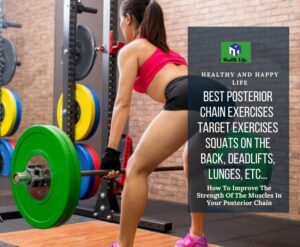The “backside of our body,” as the majority of us refer to it, is actually referred to by its anatomical name, which is the posterior chain. The glutes, hamstrings, and lower back receive the most of the attention, despite the fact that the posterior chain extends all the way down from your neck to your ankles. In this article is going to examine about what are the best posterior chain exercises and its target muscles.
Building up the strength of these muscles helps alleviate pain in the lower back, improves posture, and enhances sports performance.
In the following section, we will delve more into the characteristics of the muscles that make up the posterior chain, including how to develop these muscles and workouts that will increase their mobility and flexibility.

What Exactly Are The Muscles That Make Up The Posterior Chain?
The following are the primary muscles that make up the posterior chain:
- Gluteus: gluteus maximums, gluteus medius, and gluteus minimus.
- The semitendinosus, semimembranosus, and biceps femoris are the three muscles that make up the hamstrings.
- The muscles that go along the spine are known as the erector spinae.
- The gastrocnemius and soleus are the muscles of the calf.
There are other muscles in the upper body that are a part of the posterior chain. These muscles include the rhomboids, trapezius, and latissimus dorsi.
The glutes, hamstrings, lower back, and calves get the most of the attention, despite the fact that this particular link in the chain needs to be strengthened in order to have a healthy behind.
What Benefits Do We Derive From The Posterior Chain?
- According to a study that was conducted in 2017, having a robust posterior chain:
- Boosts power in activities that involve explosive movements.
- Enhances the performance of athletes.
- Prevents injuries.
- Helps muscles deal with forces they weren’t expecting.
- Helps maintaining posture.
The muscles that make up the posterior chain of the upper body are responsible for pulling and extending the trunk and the arms. Although each muscle in the posterior chain performs its own job, the group of muscles also collaborates to form a kinetic chain that has a synergistic effect.
Your posterior chain is an essential component in providing support for you as you go about your daily tasks. Unfortunately, sitting “shuts off” the muscles that make up the posterior chain. This frequently results in muscle imbalances, weakness, and tight hip flexors, all of which can wreak havoc on your lower back. Moreover, tight hip flexors might make it more difficult to perform certain exercises.
What’s the upbeat report? Targeting the posterior chain on a consistent basis during a full-body or lower-body workout can assist in correcting these imbalances and reduce the likelihood of sustaining an injury to the lower back.
What Is The Most Effective Way To Strengthen The Muscles In The Posterior Chain?
According to the American Council on Exercise, in order to strengthen the posterior chain, it is necessary to contract and lengthen the muscles collectively, in a chain-like way (ACE).
The exercises that are presented below are examples of compound movements, meaning that their execution requires the participation of two or more muscles from the posterior chain.
Kettlebell Swing.
Swings with a kettlebell are one of the most effective ways to improve explosive hip strength while also working the glutes, hamstrings, and quadriceps. Additionally, a strong core and upper body strength are required for it.
How To Perform A Swing With A Kettlebell.
- Place a kettlebell on the ground in front of you. Position your feet so that they are shoulder-width apart and stand over it.
- Bring your shoulders down and back, and tighten up the muscles in your core.
- In order to pick up the kettlebell, you should first press your hips back and then bend your knees as you rotate your torso forward.
- Hold the kettlebell firmly in your grasp with both hands, and make sure your shoulders are pulled back.
- To fully stretch your hips, contract your glutes and hamstrings, and then swing the kettlebell out in front of your body until it is at chest height.
- To repeat the action, start in the opposite position and swing through your legs.
Romanian Deadlift.
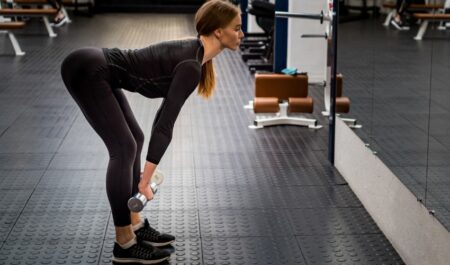
The Romanian deadlift is a complex movement that works a number of different joints in the body. According to the American College of Sports Medicine, this exercise is renowned for targeting the hamstrings and glutes in a particularly targeted manner (ACSM).
Instructions On How To Perform A Romanian Deadlift.
- Maintain a shoulder-width distance between your feet when you stand. If you want to wield a kettlebell, dumbbell, or barbell with each hand, use an overhand grip, and if you want to handle a barbell, use both hands. Shoulder-width should be used for the grip.
- Keep your shoulders pulled back and down, and maintain a flat back position.
- To bring the weight closer to your feet, you should first push your hips back, and then gently bend your knees. The hamstrings should feel like they are being stretched out. Maintain a close proximity between the bar, the kettlebells, or the dumbbells.
- Reverse the movement by thrusting the hips forward and coming back to the starting position while maintaining a close grip on the weight.
Back Squats.
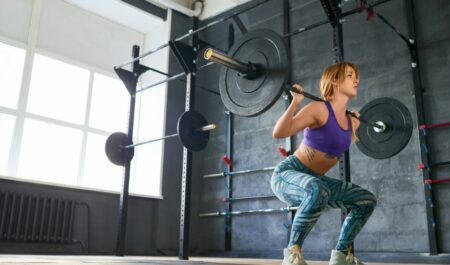
When compared to front squats, back squats provide a higher emphasis on the muscles that make up the posterior chain. Although both exercises work the same muscles in the lower body, the back squat places a greater emphasis on the glutes, hamstrings, and lower back, with the quads and calves only contributing in a supporting role.
How To Perform A Squat Using Your Back.
- Place the barbell behind your back and stand in a squat rack. Toes should be directed slightly outward, and feet should be spaced shoulder-width apart.
- Take a few steps back until the bar is balanced on your shoulders (back of neck). Grab the bar using an overhand grip that is broad.
- Take a few steps forward and the bar will come off its hinges. Squat down while maintaining an upright chest position. Continue lowering yourself until your thighs are parallel to the floor, then pause.
- Apply pressure through the sole of your foot and stand up to return to the starting position.
Pullups.
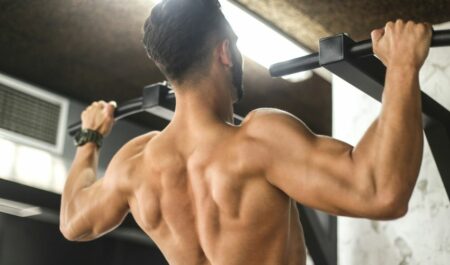
The pullup works all of the muscles in the posterior chain of the upper body, including the latissimus dorsi, trapezius, rhomboids, rear shoulders, and erector spinae.
How To Perform A Pull-Up.
- Place your feet just underneath a pull-up bar.
- Extend your arms upwards and grab the bar with an overhand grip that is slightly wider than the breadth of your shoulders. Your arms will be at their most outstretched position.
- At the same time as you are pulling your torso forward toward the bar, draw your shoulders down and toward each other.
- After pausing at the peak, perform the maneuver in reverse to return to the starting position.
- Pullups are a demanding workout that need a lot of upper body power and can be difficult to perform for beginners. Check out these different options for aided pullups, which can help you build strength and get you ready for a traditional pullup.
Method For Increasing Flexibility And Make Up Your Posterior Chain?
Building up the strength of the muscles in the posterior chain is just one piece of this larger kinetic jigsaw. In addition to this, you need to do workouts that stretch specific muscle groups so that your body can function at its best.
The flexibility of your glutes, hamstrings, and calves, as well as the muscles in your upper body, can all benefit from the following three exercises.
Perform The Figure-Four Stretch While Seated.
The seated figure-four stretch targets the glutes in addition to the muscles in the surrounding area. It also helps you get up off the ground and into a chair, which is where the vast majority of us spend the most of our time. This is an exercise that you can do while sitting in a chair, making it suitable for doing at work, school, or even while watching television.
How To Perform A Figure-Four Stretch While Seated.
- Maintain a tall posture while seated in a chair that won’t slide around. Your feet ought to be spaced approximately hip-width apart.
- Raise the right ankle and position it on top of the left leg, just above the knee, as you do so.
- Lean forward until you feel a stretch in the right glute. With your hands on the left shin, lean forward until you feel the stretch.
- Maintain the stretch for a period of thirty to sixty seconds.
- Place your right foot back on the ground, then switch to your left leg and repeat.
Hamstring Stretch Performed While Standing
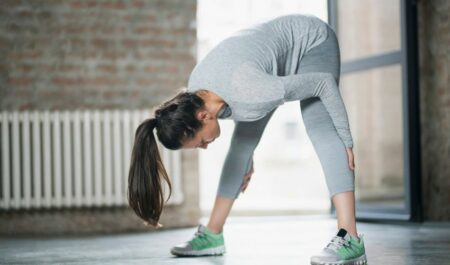
The hamstrings, as well as to a lesser extent the calves and glutes, are the primary focus of the standing hamstring stretch.
How To Perform A Hamstring Stretch While Standing.
- Maintain a lofty stance with your feet firmly planted together and your arms resting at your sides. Put your right foot in front of you and flex it toward you as you go forward.
- Engage the core muscles, then bend at the waist and stretch your hands toward the toes on your right foot. When you feel a stretch, you should stop. You may rest your hands on the upper half of your right leg if it feels comfortable to you.
- Keep your body in this position for thirty to sixty seconds.
- Return to the starting position at a slow pace, then repeat the exercise with the left leg.
- You can also perform this stretch by bringing your feet together. This will allow you to extend both legs at the same time.
Downward-Facing Dog
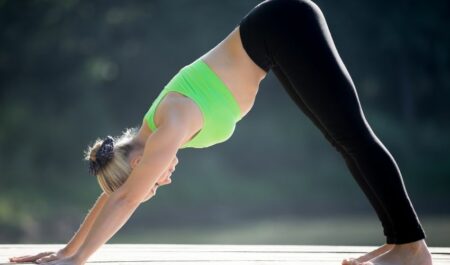
The hamstrings, glutes, shoulders, and calves are all worked on when performing the yoga pose known as Downward-Facing Dog. In addition to that, it stretches both the arms and the quadriceps.
Instructions For Performing A Downward-Facing Dog.
- Position yourself on your hands and knees, with your hands beneath your wrists and your knees beneath your hips. The distance between the hands should be that of a shoulder, and the space between the feet should be that of a hip.
- Pull your abdominal muscles in into your spine, put your weight into the palms of your hands, and elevate your knees while tucking your toes.
- While stretching the spine, bring the bottom of the tailbone up toward the ceiling. Your head should be in line with your upper arms while your arms are fully extended.
- Maintain this stance for thirty to sixty seconds while pressing your heels down toward the mat. Check that your weight is distributed properly across your body.
Takeaway.
The erector spinae, lats, and rear shoulder muscles are all part of the posterior chain of muscles, which are located on the backside of your body and comprise the glutes, hamstrings, and calves.
It is essential to improve athletic performance, maintain good back health, and maintain correct posture by include flexibility and strength training for the posterior chain as part of your entire workout program.
Consider consulting with a competent personal trainer or physical therapist if you have any issues about how to perform these techniques correctly.
